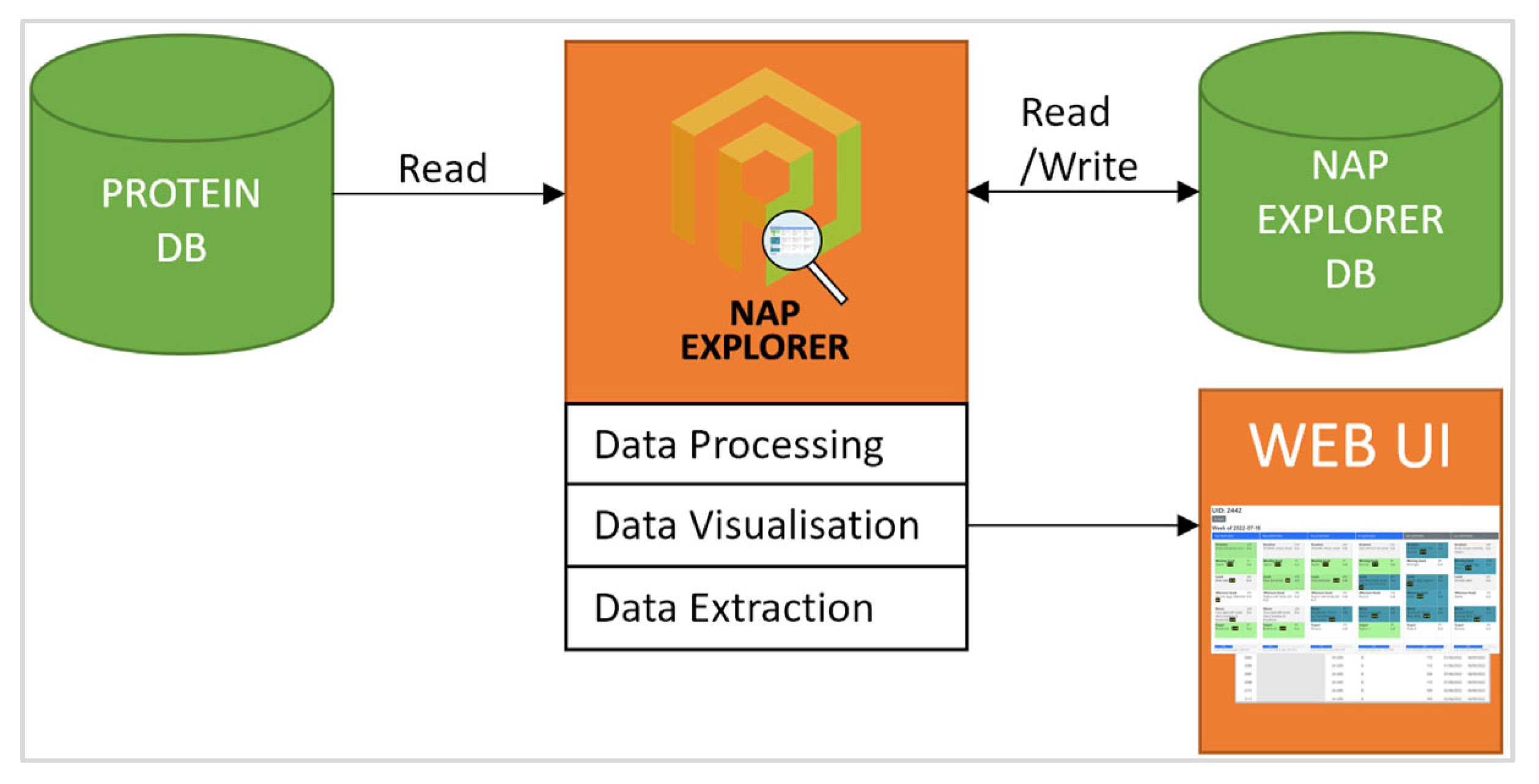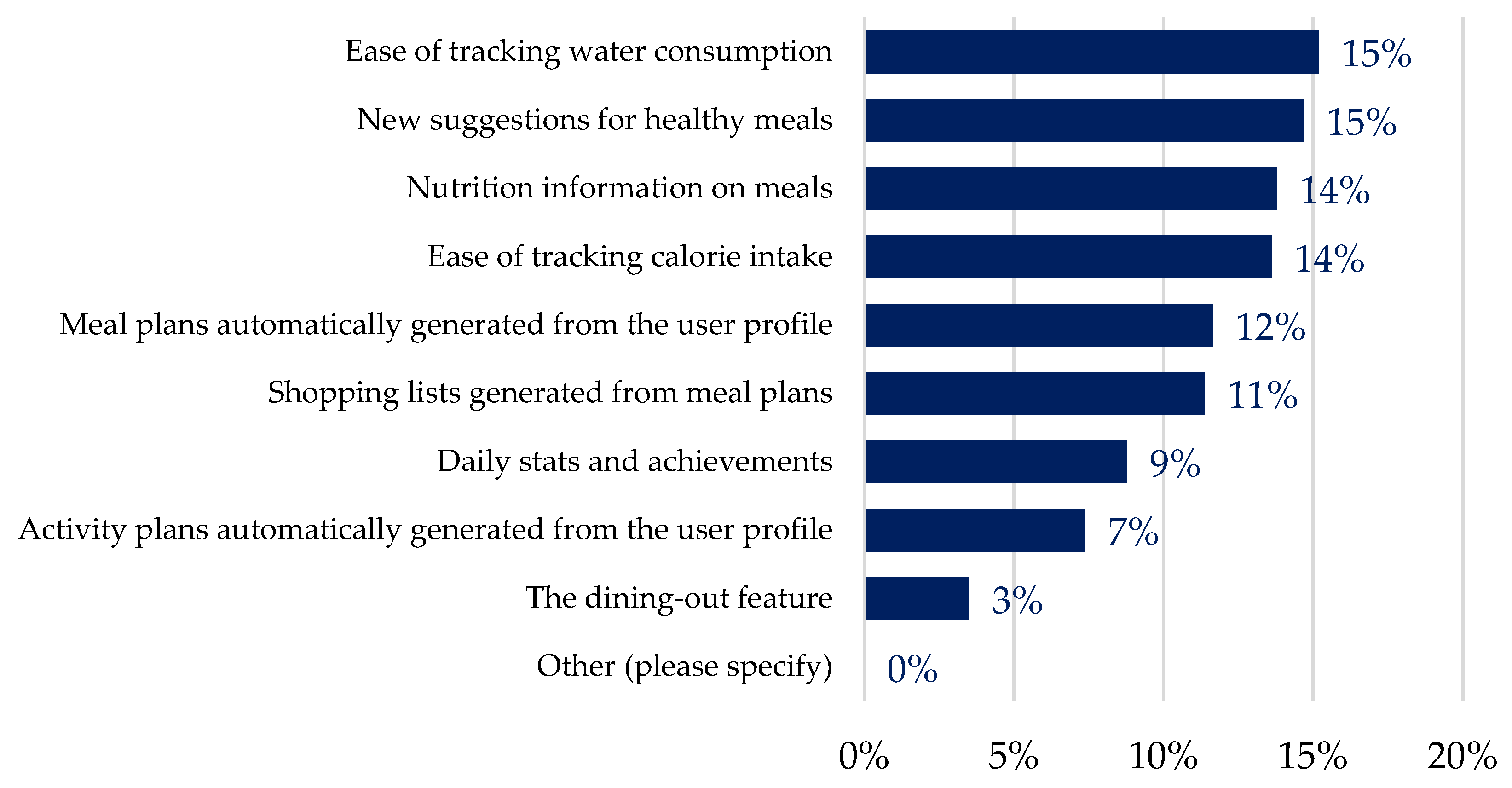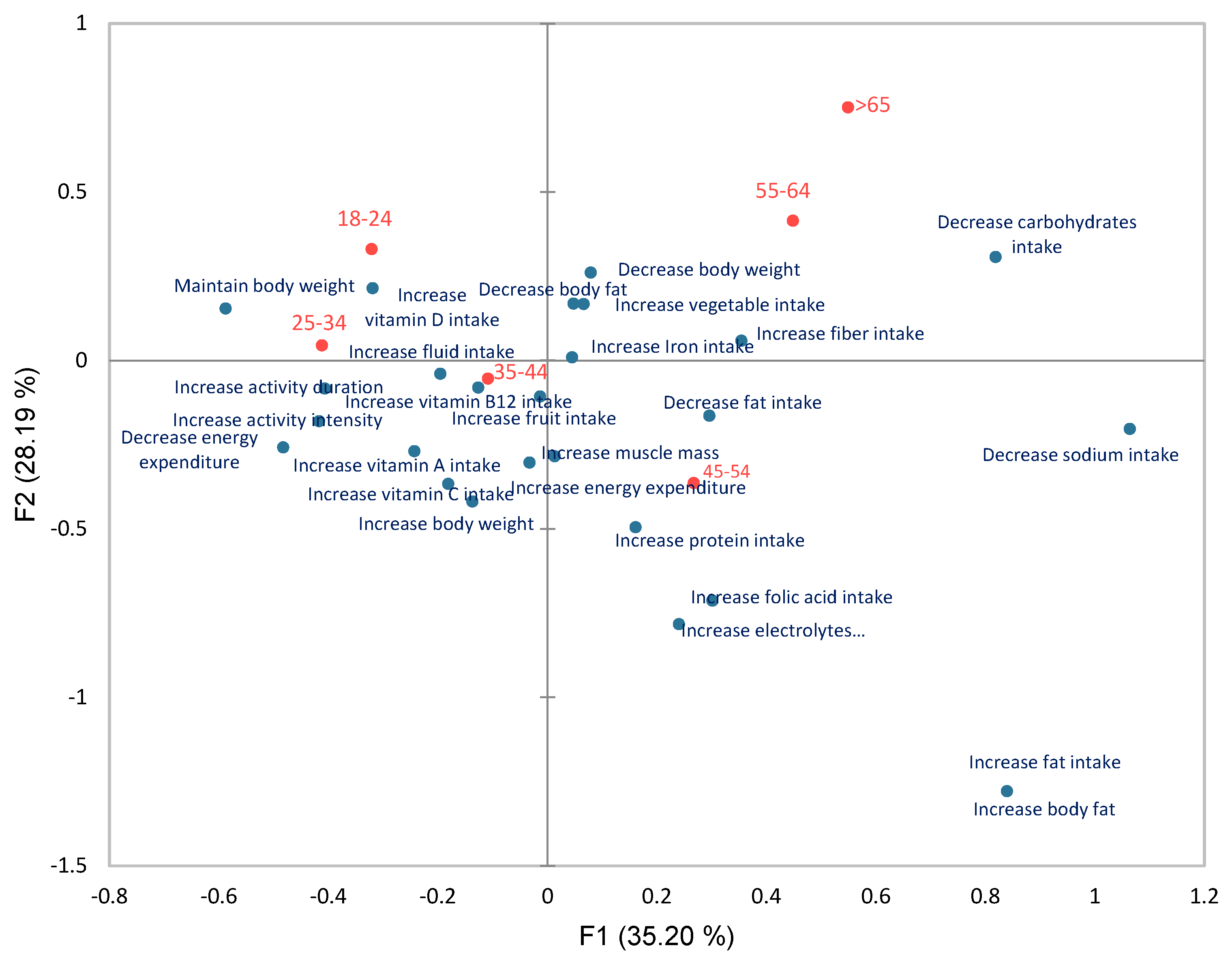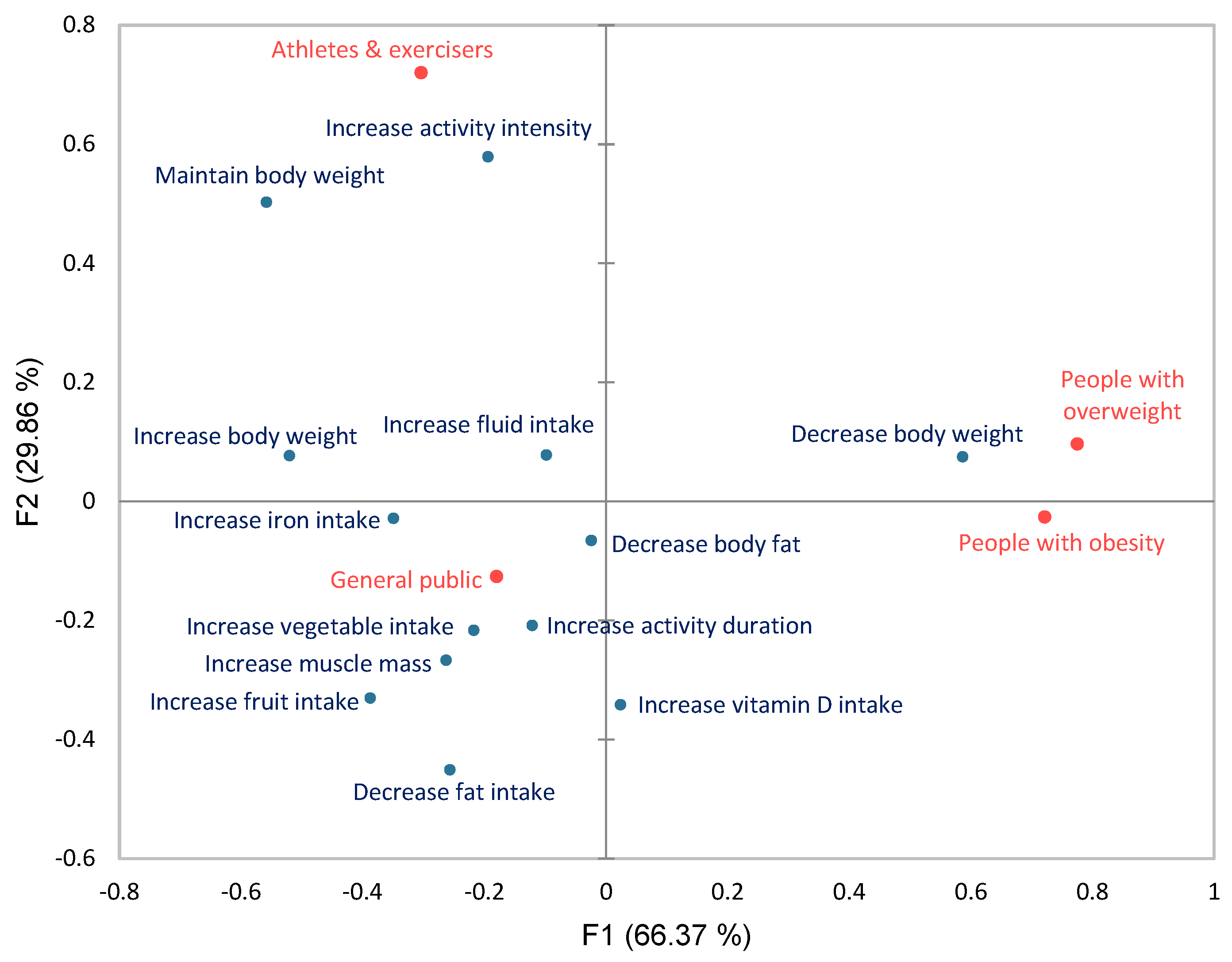Personal Goals, User Engagement, and Meal Adherence within a Personalised AI-Based Mobile Application for Nutrition and Physical Activity
Abstract
1. Introduction
2. Materials and Methods
2.1. The PROTEIN Mobile App
2.2. The PROTEIN App Pilots
2.3. Data Sources and Analysis Principles
2.4. Data Analysis
3. Results
3.1. User Demographics
3.2. Personal Goals and Motivations
Gender, Age, and User Group Associations
3.3. User Engagement and Meal Adherence
Gender, Age, and User Group Goal Associations
4. Discussion
5. Conclusions
Supplementary Materials
Author Contributions
Funding
Institutional Review Board Statement
Informed Consent Statement
Data Availability Statement
Acknowledgments
Conflicts of Interest
References
- Orte, S.; Migliorelli, C.; Sistach-Bosch, L.; Gómez-Martínez, M.; Boqué, N. A Tailored and Engaging mHealth Gamified Framework for Nutritional Behaviour Change. Nutrients 2023, 15, 1950. [Google Scholar] [CrossRef] [PubMed]
- Lim, S.Y.; Lee, K.W.; Seow, W.-L.; Mohamed, N.A.; Devaraj, N.K.; Amin-Nordin, S. Effectiveness of integrated technology apps for supporting healthy food purchasing and consumption: A systematic review. Foods 2021, 10, 1861. [Google Scholar] [CrossRef]
- Mauch, C.E.; Wycherley, T.P.; Laws, R.A.; Johnson, B.J.; Bell, L.K.; Golley, R.K. Mobile Apps to Support Healthy Family Food Provision: Systematic Assessment of Popular, Commercially Available Apps. JMIR mHealth uHealth 2018, 6, e11867. [Google Scholar] [CrossRef]
- Villinger, K.; Wahl, D.R.; Boeing, H.; Schupp, H.T.; Renner, B. The effectiveness of app-based mobile interventions on nutrition behaviours and nutrition-related health outcomes: A systematic review and meta-analysis. Obes. Rev. 2019, 20, 1465–1484. [Google Scholar] [CrossRef]
- Scarry, A.; Rice, J.; O’connor, E.M.; Tierney, A.C. Usage of Mobile Applications or Mobile Health Technology to Improve Diet Quality in Adults. Nutrients 2022, 14, 2437. [Google Scholar] [CrossRef]
- Jakob, R.; Harperink, S.; Rudolf, A.M.; Fleisch, E.; Haug, S.; Mair, J.L.; Salamanca-Sanabria, A.; Kowatsch, T. Factors Influencing Adherence to mHealth Apps for Prevention or Management of Noncommunicable Diseases: Systematic Review. J. Med. Internet Res. 2022, 24, e35371. [Google Scholar] [CrossRef] [PubMed]
- Meyerowitz-Katz, G.; Ravi, S.; Arnolda, L.; Feng, X.; Maberly, G.; Astell-Burt, T. Rates of Attrition and Dropout in App-Based Interventions for Chronic Disease: Systematic Review and Meta-Analysis. J. Med. Internet Res. 2020, 22, e20283. [Google Scholar] [CrossRef]
- Baumel, A.; Muench, F.; Edan, S.; Kane, J.M. Objective user engagement with mental health apps: Systematic search and panel-based usage analysis. J. Med. Internet Res. 2019, 21, e14567. [Google Scholar] [CrossRef]
- Amagai, S.; Pila, S.; Kaat, A.J.; Nowinski, C.J.; Gershon, R.C. Challenges in Participant Engagement and Retention Using Mobile Health Apps: Literature Review. J. Med. Internet Res. 2022, 24, e35120. [Google Scholar] [CrossRef]
- Wang, C.; Qi, H. Influencing Factors of Acceptance and Use Behavior of Mobile Health Application Users: Systematic Review. Healthcare 2021, 9, 357. [Google Scholar] [CrossRef] [PubMed]
- Dias, S.B.; Oikonomidis, Y.; Diniz, J.A.; Baptista, F.; Carnide, F.; Bensenousi, A.; Botana, J.M.; Tsatsou, D.; Stefanidis, K.; Gymnopoulos, L.; et al. Users’ Perspective on the AI-Based Smartphone PROTEIN App for Personalized Nutrition and Healthy Living: A Modified Technology Acceptance Model (mTAM) Approach. Front. Nutr. 2022, 9, 898031. [Google Scholar] [CrossRef]
- Akdur, G.; Aydin, M.N.; Akdur, G. Adoption of Mobile Health Apps in Dietetic Practice: Case Study of Diyetkolik. JMIR mHealth uHealth 2020, 8, e16911. [Google Scholar] [CrossRef] [PubMed]
- Yuan, S.; Ma, W.; Kanthawala, S.; Peng, W. Keep Using My Health Apps: Discover Users’ Perception of Health and Fitness Apps with the UTAUT2 Model. Telemed. J. e-Health 2015, 21, 735–741. [Google Scholar] [CrossRef] [PubMed]
- Bidargaddi, N.; Almirall, D.; Murphy, S.; Nahum-Shani, I.; Kovalcik, M.; Pituch, T.; Maaieh, H.; Strecher, V. To Prompt or Not to Prompt? A Microrandomized Trial of Time-Varying Push Notifications to Increase Proximal Engagement with a Mobile Health App. JMIR mHealth uHealth 2018, 6, e10123. [Google Scholar] [CrossRef]
- Bell, L.; Garnett, C.; Bao, Y.; Cheng, Z.; Qian, T.; Perski, O.; Potts, H.W.W.; Williamson, E. How Notifications Affect Engagement with a Behavior Change App: Results From a Micro-Randomized Trial. JMIR mHealth uHealth 2023, 11, e38342. [Google Scholar] [CrossRef] [PubMed]
- J-DOtis, M.; Robichaud, A.; Sartori, F.; Savi, M.; Talpini, J. Tailoring mHealth Apps on Users to Support Behavior Change Interventions: Conceptual and Computational Considerations. Appl. Sci. 2022, 12, 3782. [Google Scholar] [CrossRef]
- James, D.C.S.; Harville, C. Barriers and Motivators to Participating in mHealth Research among African American Men. Am. J. Men’s Health 2015, 11, 1605–1613. [Google Scholar] [CrossRef]
- Spaulding, E.M.; Marvel, F.A.; Piasecki, R.J.; Martin, S.S.; Allen, J.K. User Engagement with Smartphone Apps and Cardiovascular Disease Risk Factor Outcomes: Systematic Review. JMIR Cardio 2021, 5, e18834. [Google Scholar] [CrossRef] [PubMed]
- Smahel, D.; Elavsky, S.; Machackova, H. Functions of mHealth applications: A user’s perspective. Health Inform. J. 2017, 25, 1065–1075. [Google Scholar] [CrossRef]
- Locke, E.A.; Latham, G.P. Building a practically useful theory of goal setting and task motivation: A 35-year odyssey. Am. Psychol. 2002, 57, 705–717. [Google Scholar] [CrossRef]
- Ryan, R.M.; Deci, E.L. Self-determination theory and the facilitation of intrinsic motivation, social development, and well-being. Am. Psychol. 2000, 55, 68–78. [Google Scholar] [CrossRef]
- Duncan, M.J.; Wunderlich, K.; Zhao, Y.; Faulkner, G. Walk this way: Validity evidence of iphone health application step count in laboratory and free-living conditions. J. Sports Sci. 2017, 36, 1695–1704. [Google Scholar] [CrossRef] [PubMed]
- Lister, C.; West, J.H.; Cannon, B.; Sax, T.; Brodegard, D. Just a fad? Gamification in health and fitness apps. JMIR Serious Games 2014, 2, e9. [Google Scholar] [CrossRef] [PubMed]
- Conroy, D.E.; Yang, C.H.; Maher, J.P. Behavior change techniques in top-ranked mobile apps for physical activity. Am. J. Prev. Med. 2014, 46, 649–652. [Google Scholar] [CrossRef] [PubMed]
- Bandura, A. Social cognitive theory of self-regulation. Organ. Behav. Hum. Decis. Process. 1991, 50, 248–287. [Google Scholar] [CrossRef]
- Wilson-Barnes, S.; Gymnopoulos, L.P.; Dimitropoulos, K.; Solachidis, V.; Rouskas, K.; Russell, D.; Oikonomidis, Y.; Hadjidimitriou, S.; Botana, J.M.; Brkic, B.; et al. PeRsOnalised nutriTion for hEalthy livINg: The PROTEIN project. Nutr. Bull. 2021, 46, 77–87. [Google Scholar] [CrossRef]
- Stefanidis, K.; Tsatsou, D.; Konstantinidis, D.; Gymnopoulos, L.; Daras, P.; Wilson-Barnes, S.; Hart, K.; Cornelissen, V.; Decorte, E.; Lalama, E.; et al. PROTEIN AI Advisor: A Knowledge-Based Recommendation Framework Using Expert-Validated Meals for Healthy Diets. Nutrients 2022, 14, 4435. [Google Scholar] [CrossRef]
- Tsatsou, D.; Lalama, E.; Wilson-Barnes, S.L.; Hart, K.; Cornelissen, V.; Buys, R.; Pagkalos, I.; Dias, S.B.; Dimitropoulos, K.; Daras, P. NAct: The Nutrition & Activity Ontology for Healthy Living. Front. Artif. Intell. Appl. 2021, 344, 129–143. [Google Scholar] [CrossRef]
- Wilson-Barnes, S.L.; Pagkalos, I.; Patra, E.; Kokkinopoulou, A.; Hassapidou, M.; Lalama, E.; Csanalosi, M.; Kabisch, S.; Pfeiffer, A.F.H.; DeCorte, E.; et al. The development of an EU-wide nutrition and physical activity expert knowledge base to support a personalised mobile application across various EU population groups. Nutr. Bull. 2024, 49, 220–234. [Google Scholar] [CrossRef] [PubMed]
- Mustafa, A.S.; Ali, N.; Dhillon, J.S.; Alkawsi, G.; Baashar, Y. User Engagement and Abandonment of mHealth: A Cross-Sectional Survey. Healthcare 2022, 10, 221. [Google Scholar] [CrossRef]
- Bhuyan, S.S.; Lu, N.; Chandak, A.; Kim, H.; Wyant, D.; Bhatt, J.; Kedia, S.; Chang, C.F. Use of Mobile Health Applications for Health-Seeking Behavior among US Adults. J. Med. Syst. 2016, 40, 153. [Google Scholar] [CrossRef] [PubMed]
- Yoon, S.; Kwan, Y.H.; Phang, J.K.; Tan, W.B.; Low, L.L. Personal Goals, Barriers to Self-Management and Desired mHealth Application Features to Improve Self-Care in Multi-Ethnic Asian Patients with Type 2 Diabetes: A Qualitative Study. Int. J. Environ. Res. Public Health 2022, 19, 15415. [Google Scholar] [CrossRef] [PubMed]
- Ernsting, C.; Dombrowski, S.U.; Oedekoven, M.; O’sUllivan, J.L.; Kanzler, M.; Kuhlmey, A.; Gellert, P. Using smartphones and health apps to change and manage health behaviors: A population-based survey. J. Med. Internet Res. 2017, 19, e101. [Google Scholar] [CrossRef]
- Egilsson, E.; Bjarnason, R.; Njardvik, U. Usage and Daily Attrition of a Smartphone-Based Health Behavior Intervention: Randomized Controlled Trial. JMIR mHealth uHealth 2023, 11, e45414. [Google Scholar] [CrossRef]
- Deniz-Garcia, A.; Fabelo, H.; Rodriguez-Almeida, A.J.; Zamora-Zamorano, G.; Castro-Fernandez, M.; Ruano, M.d.P.A.; Solvoll, T.; Granja, C.; Schopf, T.R.; Callico, G.M.; et al. Quality, Usability, and Effectiveness of mHealth Apps and the Role of Artificial Intelligence: Current Scenario and Challenges. J. Med. Internet Res. 2023, 25, e44030. [Google Scholar] [CrossRef]
- Pratap, A.; Neto, E.C.; Snyder, P.; Stepnowsky, C.; Elhadad, N.; Grant, D.; Mohebbi, M.H.; Mooney, S.; Suver, C.; Wilbanks, J.; et al. Indicators of retention in remote digital health studies: A cross-study evaluation of 100,000 participants. npj Digit. Med. 2020, 3, 21. [Google Scholar] [CrossRef]
- Nuijten, R.; Van Gorp, P.; Khanshan, A.; Le Blanc, P.; Berg, P.v.D.; Kemperman, A.; Simons, M. Evaluating the Impact of Adaptive Personalized Goal Setting on Engagement Levels of Government Staff with a Gamified mHealth Tool: Results From a 2-Month Randomized Controlled Trial. JMIR mHealth uHealth 2022, 10, e28801. [Google Scholar] [CrossRef]
- Bandura, A.; Schunk, D.H. Cultivating competence, self-efficacy, and intrinsic interest through proximal self-motivation. J. Pers. Soc. Psychol. 1981, 41, 586–598. [Google Scholar] [CrossRef]
- Latham, G.P. The reciprocal effects of science on practice: Insights from the practice and science of goal setting. Can. Psychol. Can. 2001, 42, 1–11. [Google Scholar] [CrossRef]
- Latham, G.P.; Locke, E.A. Self-regulation through goal setting. Organ. Behav. Hum. Decis. Process. 1991, 50, 212–247. [Google Scholar] [CrossRef]
- Baek, H.; Suh, J.-W.; Kang, S.-H.; Kang, S.; Lim, T.H.; Hwang, H.; Yoo, S. Enhancing User Experience Through User Study: Design of an mHealth Tool for Self-Management and Care Engagement of Cardiovascular Disease Patients. JMIR Cardio 2018, 2, e3. [Google Scholar] [CrossRef] [PubMed]






| Variable | PROTEIN Database | PROTEIN End-User Questionnaire |
|---|---|---|
| n (%) | n (%) | |
| Total | 579 | 446 |
| Gender | ||
| Male | 255 (44.0) | 163 (36.5) |
| Female | 324 (56.0) | 282 (63.2) |
| Rather not say | - | 1 (0.2) |
| Age (years) | ||
| 18–24 | 90 (15.5) | 47 (10.5) |
| 25–34 | 157 (27.1) | 129 (28.9) |
| 35–44 | 150 (25.9) | 134 (30.0) |
| 45–54 | 76 (13.1) | 74 (16.6) |
| 55–64 | 76 (13.1) | 37 (8.3) |
| >65 | 30 (5.2) | 25 (5.6) |
| User Group | ||
| Group A: Users with no health conditions, normal BMI, non-exercisers | 289 (49.9) | 129 (28.9) |
| Group B: Athletes and leisure exercisers | 98 (16.9) | 52 (11.7) |
| Group B: People with overweight | 77 (13.3) | 125 (28.0) |
| Group C: People with obesity | 46 (7.9) | 21 (4.7) |
| Group C: People with CVD | 14 (2.4) | 9 (2.0) |
| Group C: People with T2D | 21 (3.6) | 9 (2.0) |
| Group C: People with iron-deficiency anaemia | 10 (1.7) | 13 (2.9) |
| Group C: People with PQD | 24 (4.1) | 83 (18.6) |
| Other | N/A | 5 (1.1) |
Disclaimer/Publisher’s Note: The statements, opinions and data contained in all publications are solely those of the individual author(s) and contributor(s) and not of MDPI and/or the editor(s). MDPI and/or the editor(s) disclaim responsibility for any injury to people or property resulting from any ideas, methods, instructions or products referred to in the content. |
© 2024 by the authors. Licensee MDPI, Basel, Switzerland. This article is an open access article distributed under the terms and conditions of the Creative Commons Attribution (CC BY) license (https://creativecommons.org/licenses/by/4.0/).
Share and Cite
Patra, E.; Kokkinopoulou, A.; Wilson-Barnes, S.; Hart, K.; Gymnopoulos, L.P.; Tsatsou, D.; Solachidis, V.; Dimitropoulos, K.; Rouskas, K.; Argiriou, A.; et al. Personal Goals, User Engagement, and Meal Adherence within a Personalised AI-Based Mobile Application for Nutrition and Physical Activity. Life 2024, 14, 1238. https://doi.org/10.3390/life14101238
Patra E, Kokkinopoulou A, Wilson-Barnes S, Hart K, Gymnopoulos LP, Tsatsou D, Solachidis V, Dimitropoulos K, Rouskas K, Argiriou A, et al. Personal Goals, User Engagement, and Meal Adherence within a Personalised AI-Based Mobile Application for Nutrition and Physical Activity. Life. 2024; 14(10):1238. https://doi.org/10.3390/life14101238
Chicago/Turabian StylePatra, Elena, Anna Kokkinopoulou, Saskia Wilson-Barnes, Kathryn Hart, Lazaros P. Gymnopoulos, Dorothea Tsatsou, Vassilios Solachidis, Kosmas Dimitropoulos, Konstantinos Rouskas, Anagnostis Argiriou, and et al. 2024. "Personal Goals, User Engagement, and Meal Adherence within a Personalised AI-Based Mobile Application for Nutrition and Physical Activity" Life 14, no. 10: 1238. https://doi.org/10.3390/life14101238
APA StylePatra, E., Kokkinopoulou, A., Wilson-Barnes, S., Hart, K., Gymnopoulos, L. P., Tsatsou, D., Solachidis, V., Dimitropoulos, K., Rouskas, K., Argiriou, A., Lalama, E., Csanalosi, M., Pfeiffer, A. F. H., Cornelissen, V., Decorte, E., Dias, S. B., Oikonomidis, Y., María Botana, J., Leoni, R., ... Pagkalos, I. (2024). Personal Goals, User Engagement, and Meal Adherence within a Personalised AI-Based Mobile Application for Nutrition and Physical Activity. Life, 14(10), 1238. https://doi.org/10.3390/life14101238










